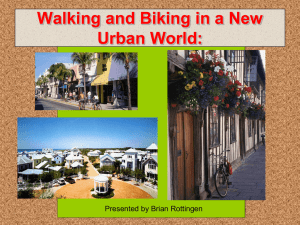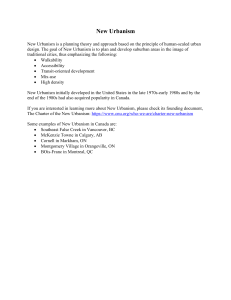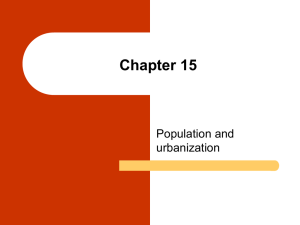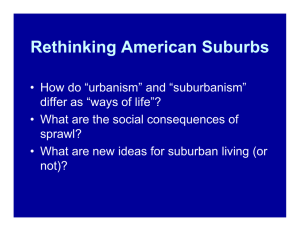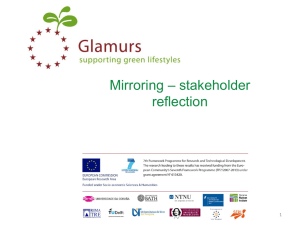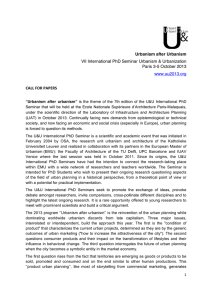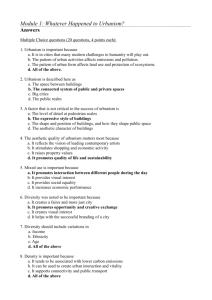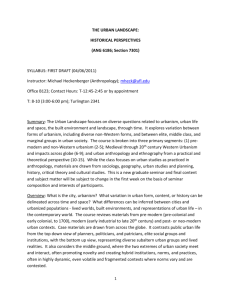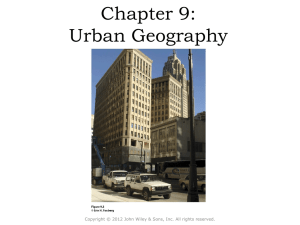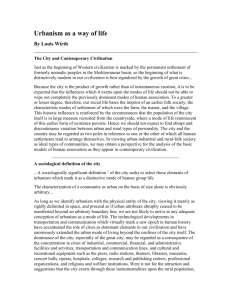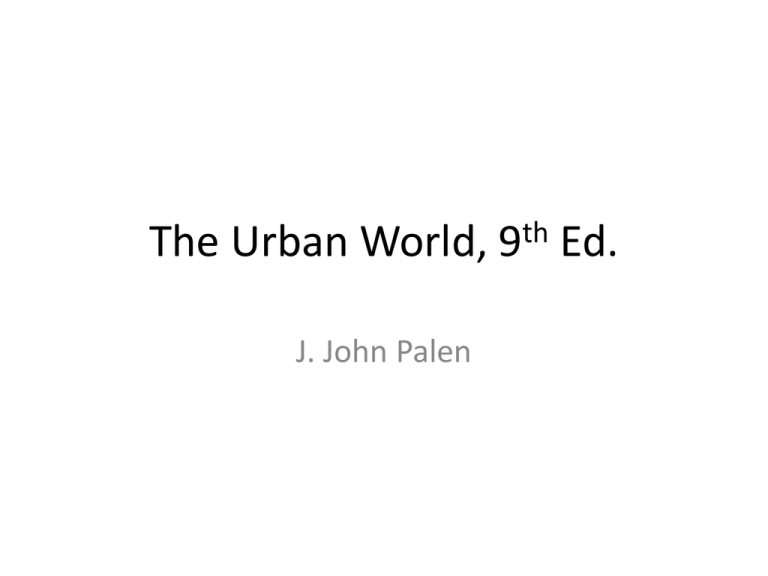
The Urban World,
J. John Palen
th
9
Ed.
Chapter 7: Urban Culture and
Lifestyles
• Introduction
• Social Psychology of Urban Life
• Reevaluations of Urbanism and Social
Disorganization
• Characteristics of Urban Populations
• Urban Lifestyles
• A Final Note of Caution
• Summary
Introduction
• Move to the consideration of the city as a
unique social organizational form and social
milieu
• Urbanism rather than urbanization
• Understanding the influences of the beliefs
and myths about city, suburban, and rural life
Social Psychology of Urban Life
• Early Formulations
– Tönnies’s description of the shift from
gemeinschaft (a community where ties are based
upon kinship) to gesellschaft (a society based on
common economic, political, and other interests)
– Karl Marx’s dichotomy between the urban and the
rural
– In all frameworks, the rural represents the past
• The Chicago School
– Concerned with examining scientifically the
changes produced by urbanization
– Influenced by Georg Simmel’s earlier vision of the
social-psychological consequences of city life
• “Urbanism as a Way of Life”
– Louis Wirth argued that the city created a distinct
way of life—called “urbanism”—that is reflected
in how people dress and speak, what they believe
about the social world, what they consider worth
achieving, what they do for a living, where they
live, with whom they associate, and why they
interact with other people
Reevaluations of Urbanism and Social
Disorganization
• Determinist Theory
– Wirthian social disorganization, which included decline of
family and weakening of bonds, breakdown of primary
groups, and decline of cultural homogeneity
– Community Lost: urbanization is said to more or less
automatically produce the characteristics of urbanism as a
way of life
• Compositional Theory
– Gans suggests that the city is composed of not just one
urban way of life but rather a wide variety of lifestyles
– The nature of the individual’s local community and primary
groups are most important
• Subcultural Theory
– Claude Fischer argues that space does matter, and
there is something different about cities
– Urbanization strengthens and intensifies
subcultural groups
– Being middle class in a small town is not the same
as being middle class in a city
– Size does matter
Characteristics of Urban Populations
• Age
– Urban population is younger than rural because
they attract immigrants
– Cities have more activities for young adults
• Gender
– Less-developed countries have a higher
proportion of urban males
– Developed countries there is a higher likelihood
that single women will leave rural areas for city
jobs
• Race, Ethnicity, and Religion
– Cities more heterogeneous than small towns
– Raises the potential of intergroup cleavage,
competition, and conflict
• More likely when represented by socioeconomic status
boundaries
• Socioeconomic Status
– North American cities have been losing middleclass residents since World War II
– Overall city income averages tend to hide sharp
individual and neighborhood variations in
socioeconomic status
Urban Lifestyles
• Cosmopolites
– Urban sophisticates, most often having incomes to match their
lifestyles
• Unmarried or Childless
– Overlap with the cosmopolites; younger and apartment
dwellers
– Brains have replaced money and accomplishment trumps
religion and wealth
• Gay Households
– Estimated to be some 8.8 million gay, lesbian, or bisexual
persons in the United States
– According to the U.S. census, gay male households are more
likely to live in downtown gay neighborhoods, while lesbians
more commonly reside in suburban areas
• Ethnic Villagers
– Residents in neighborhoods dominated by a single
ethnic group often called “urban villagers” or “urban
provincials”
– Often mislabeled as slums
• Neighborhood Characteristics
– Territoriality: strong sense of territory
– Ordered Segmentation: each ethnic group carefully
and specifically defines its territory
– Peer-Group Orientation: a group made up of members
of the same age and sex who are at the same stage of
the lifecycle
– Family Norms: Family life in middle-class families is
child-oriented, but in settled, ethnic, working-class
areas family life is generally adult-oriented
– Housing: not primarily viewed as a status symbol
– Imagery and Vulnerability: psychological distance
from the city; they are “in” but not “of” the city
• Vulnerable to change induced from the outside
• Deprived or Trapped
– For the 15 to 20 percent of the population who
are the bottom, the slum has the character more
of an urban jungle than an urban village
– Most of the residents of unstable slums are for all
practical purposes excluded from the economic
and social life of the larger society
– Housing Problems
A Final Note of Caution
• Urbanism as a way of life is remarkably diverse
• There is no single urban lifestyle per se
• It is important to distinguish between the
different urban lifestyles

